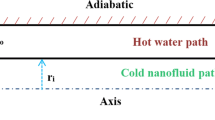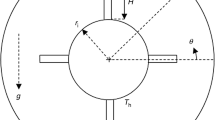Abstract
The main objective of this research is to study the effects of nanoparticle shape on the entropy generation characteristics of boehmite alumina nanofluid flow in a horizontal double-pipe heat exchanger. The examined boehmite alumina nanofluids include dispersed cylindrical, brick, blade, platelet and spherical nanoparticles in a mixture of water/ethylene glycol. The nanofluid and water flow through the tube side and annulus side of the heat exchanger, respectively. Two-phase mixture model is applied to precisely simulate the behavior of nanofluid. The effects of the various Reynolds numbers, nanoparticle concentrations and nanoparticle shapes on the frictional, thermal and total entropy generation rates as well as the Bejan number are numerically investigated. The results indicated that the highest and lowest frictional entropy generation rate belongs to the nanofluids with platelet shape and spherical shape nanoparticles, respectively, while the nanofluid containing spherical shape and platelet shape nanoparticles represented the maximum and minimum thermal and total entropy generation rates. Furthermore, it was inferred that the frictional entropy generation rate is enhanced with an increase in nanoparticle concentration, whereas except for nanofluid with spherical shape nanoparticles, the opposite is true for thermal and total entropy generation rates and Bejan number.











Similar content being viewed by others
Abbreviations
- \(Be\) :
-
Bejan number
- \(C_{\text{p}}\) :
-
Specific heat (J kg−1 K−1)
- \(d\) :
-
Diameter (m)
- \(f_{\text{drag}}\) :
-
Drag coefficient
- \(g\) :
-
Gravitational acceleration (m s−2)
- \(G_{\text{k}}\) :
-
Rate of generation of turbulent kinetic energy (kg m−1 s−3)
- \(k\) :
-
Turbulent kinetic energy (m2 s−2)
- \(p\) :
-
Pressure (Pa)
- \(Re\) :
-
Reynolds number
- \(\dot{S}_{{{\text{g}},{\text{f}}}}^{{{\prime \prime \prime }}}\) :
-
Local frictional entropy generation rate (W m−3 K−1)
- \(\dot{S}_{{{\text{g}},{\text{h}}}}^{{{\prime \prime \prime }}}\) :
-
Local thermal entropy generation rate (W m−3 K−1)
- \(\dot{S}_{{{\text{g}},{\text{t}}}}^{{{\prime \prime \prime }}}\) :
-
Local total entropy generation rate (W m−3 K−1)
- \(\dot{S}_{{{\text{g}},{\text{f}}}}\) :
-
Global frictional entropy generation rate (W m−3 K−1)
- \(\dot{S}_{{{\text{g}},{\text{h}}}}\) :
-
Global thermal entropy generation rate (W m−3 K−1)
- \(\dot{S}_{{{\text{g}},{\text{t}}}}\) :
-
Global total entropy generation rate (W m−3 K−1)
- \(T\) :
-
Temperature (K)
- \(V_{\text{dr}}\) :
-
Drift velocity (m s−1)
- \(V_{\text{m}}\) :
-
Mixture velocity (m s−1)
- \(V_{\text{pf}}\) :
-
Relative velocity between a particle and fluid (m s−1)
- \(v_{x}\) :
-
x-component of velocity (m s−1)
- \(v_{y}\) :
-
y-component of velocity (m s−1)
- \(\varepsilon\) :
-
Turbulent dissipation rate (m2 s−3)
- λ :
-
Thermal conductivity (W m−1 K−1)
- \(\mu\) :
-
Viscosity (kg m−1 s−1)
- \(\mu_{\tau }\) :
-
Turbulent viscosity (kg m−1 s−1)
- \(\rho\) :
-
Density (kg m−3)
- \(\varphi\) :
-
Volume concentration
- f:
-
Base fluid
- m:
-
Mixture
- p:
-
Nanoparticle
References
Sheikholeslami M. CVFEM for magnetic nanofluid convective heat transfer in a porous curved enclosure. Eur Phys J Plus. 2016;131:413.
Sheikholeslami M, Hayat T, Alsaedi A. Numerical simulation of nanofluid forced convection heat transfer improvement in existence of magnetic field using lattice Boltzmann method. Int J Heat Mass Transfer. 2017;108:1870–83.
Sheikholeslami M. Influence of Coulomb forces on Fe3O4–H2O nanofluid thermal improvement. Int J Hydrogen Energy. 2017;42:821–9.
Bovand M, Rashidi S, Ahmadi G, Abolfazli Esfahani J. Effects of trap and reflect particle boundary conditions on particle transport and convective heat transfer for duct flow—A two-way coupling of Eulerian-Lagrangian model. Appl Therm Eng. 2016;108:368–77.
Rashidi S, Mahian O, Mohseni Languri E. Applications of nanofluids in condensing and evaporating systems. J Therm Anal Calorim. 2018;131:2027–39.
Rashidi S, Eskandarian M, Mahian O, Poncet S. Combination of nanofluid and inserts for heat transfer enhancement. J Therm Anal Calorim. 2018. https://doi.org/10.1007/s10973-018-7070-9.
Khajeh Arzani H, Amiri A, Khajeh Arzani H, Bin Rozali S, Kazi SN, Badarudin A. Toward improved heat transfer performance of annular heat exchangers with water/ethylene glycol-based nanofluids containing graphene nanoplatelets. J Therm Anal Calorim. 2016;126:1427–36.
Raei B, Shahraki F, Jamialahmadi M, Peyghambarzadeh SM. Experimental study on the heat transfer and flow properties of γ-Al2O3/water nanofluid in a double-tube heat exchanger. J Therm Anal Calorim. 2016;127:2561–75.
Hosseinnezhad R, Ali Akbari O, Hassanzadeh Afrouzi H, Biglarian M, Koveiti A, Toghraie D. Numerical study of turbulent nanofluid heat transfer in a tubular heat exchanger with twin twisted-tape inserts. J Therm Anal Calorim. 2018;132:741–59.
Kumar V, Pandya N, Pandya B, Joshi A. Synthesis of metal-based nanofluids and their thermo-hydraulic performance in compact heat exchanger with multi-louvered fins working under laminar conditions. J Therm Anal Calorim. 2018. https://doi.org/10.1007/s10973-018-7304-x.
Mansoury D, Doshmanziari FI, Rezaie S, Rashidi MM. Effect of Al2O3/water nanofluid on performance of parallel flow heat exchangers. J Therm Anal Calorim. 2018. https://doi.org/10.1007/s10973-018-7286-8.
Jafaryar M, Sheikholeslami M, Li Z. CuO-water nanofluid flow and heat transfer in a heat exchanger tube with twisted tape turbulator. Powder Technol. 2018;336:131–43.
Bahiraei M, Berahmand M, Shahsavar A. Irreversibility analysis for flow of a non-Newtonian hybrid nanofluid containing coated CNT/Fe3O4 nanoparticles in a minichannel heat exchanger. Appl Therm Eng. 2017;125:1083–93.
Shahsavar A, Rahimi Z, Bahiraei M. Optimization of irreversibility and thermal characteristics of a mini heat exchanger operated with a new hybrid nanofluid containing carbon nanotubes decorated with magnetic nanoparticles. Energy Convers Manage. 2017;150:37–47.
Esfahani JA, Akbarzadeh M, Rashidi S, Rosen MA, Ellahi R. Influences of wavy wall and nanoparticles on entropy generation over heat exchanger plat. Int J Heat Mass Transfer. 2017;109:1162–71.
Li Z, Sheikholeslami M, Jafaryar M, Shafee A, Chamkha AJ. Investigation of nanofluid entropy generation in a heat exchanger with helical twisted tapes. J Mol Liq. 2018;266:797–805.
Akbarzadeh M, Rashidi S, Karimi N, Omar N. First and second laws of thermodynamics analysis of nanofluid flow inside a heat exchanger duct with wavy walls and a porous insert. J Therm Anal Calorim. 2018. https://doi.org/10.1007/s10973-018-7044-y.
Avella M, Cosco S, Di Lorenzo ML, Di Pace E, Errico ME. Influence of CaCO3 nanoparticles shape on thermal and crystallization behavior of isotactic polypropylene based nanocomposites. J Therm Anal Calorim. 2005;80:131–6.
Zhou XF, Gao L. Effective thermal conductivity in nanofluids of nonspherical particles with interfacial thermal resistance: differential effective medium theory. J Appl Phys. 2006;100:024913.
Timofeeva EV, Routbort JL, Singh D. Particle shape effects on thermophysical properties of alumina nanofluids. J Appl Phys. 2009;106:014304.
Elias MM, Shahrul IM, Mahbubul IM, Saidur R, Rahim NA. Effect of different nanoparticle shapes on shell and tube heat exchanger using different baffle angles and operated with nanofluid. Int J Heat Mass Transfer. 2014;70:289–97.
Elias MM, Miqdad M, Mahbubul IM, Saidur R, Kamalisarvestani M, Sohel MR, Hepbasli A, Rahim NA, Amalina MA. Effect of nanoparticle shape on the heat transfer and thermodynamic performance of a shell and tube heat exchanger. Int Commun Heat Mass Transfer. 2013;44:93–9.
Sheikholeslami M, Bhatti MM. Forced convection of nanofluid in presence of constant magnetic field considering shape effects of nanoparticles. Int J Heat Mass Transfer. 2017;111:1039–49.
Hajabdollahi H, Hajabdollahi Z. Numerical study on impact behavior of nanoparticle shapes on the performance improvement of shell and tube heat exchanger. Chem Eng Res Des. 2017;125:449–60.
Mahian O, Kianifar A, Zeinali Heris S, Wongwises S. First and second laws analysis of a minichannel-based solar collector using boehmite alumina nanofluids: effects of nanoparticle shape and tube materials. Int J Heat Mass Transfer. 2014;78:1166–76.
Arani AAA, Sadripour S, Kermani S. Nanoparticle shape effects on thermal-hydraulic performance of boehmite alumina nanofluids in a sinusoidal-wavy mini-channel with phase shift and variable wavelength. Int J Mech Sci. 2017;128–129:550–63.
Hamilton R, Crosser O. Thermal conductivity of heterogeneous two-component systems. Ind Eng Chem Fundam. 1962;1:187–91.
Manninen M, Taivassalo V, Kallio S. On the mixture model for multiphase flow, Technical Research Centre of Finland; 1996.
Schiller L, Neumann A. A drag coefficient correlation. Vdi Zeitung. 1935;77:51.
Launder BE, Sharma BI. Application of the energy-dissipation model of turbulence to the calculation of flow near a spinning disc. Lett Heat Mass Transfer. 1974;1:131–7.
Bejan A. A study of entropy generation in fundamental convective heat transfer. ASME J Heat Transfer. 1979;101:718–25.
Duangthongsuk W, Wongwises S. An experimental study on the heat transfer performance and pressure drop of TiO2-water nanofluids flowing under a turbulent flow regime. Int J Heat Mass Transfer. 2010;53:334–44.
Author information
Authors and Affiliations
Corresponding author
Rights and permissions
About this article
Cite this article
Monfared, M., Shahsavar, A. & Bahrebar, M.R. Second law analysis of turbulent convection flow of boehmite alumina nanofluid inside a double-pipe heat exchanger considering various shapes for nanoparticle. J Therm Anal Calorim 135, 1521–1532 (2019). https://doi.org/10.1007/s10973-018-7708-7
Received:
Accepted:
Published:
Issue Date:
DOI: https://doi.org/10.1007/s10973-018-7708-7




